
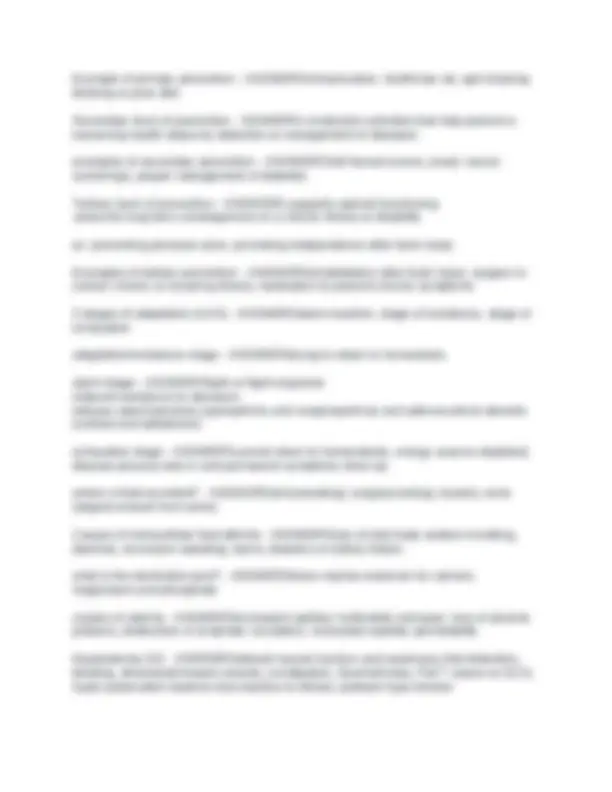
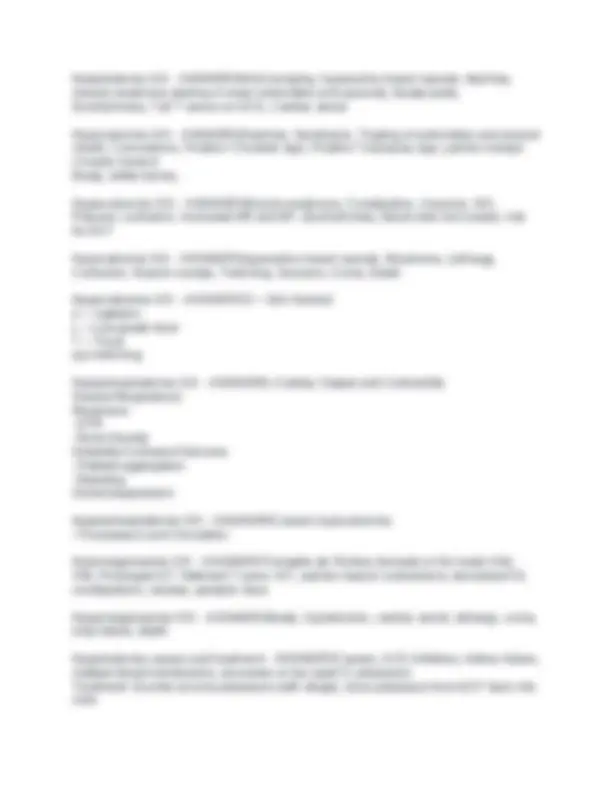
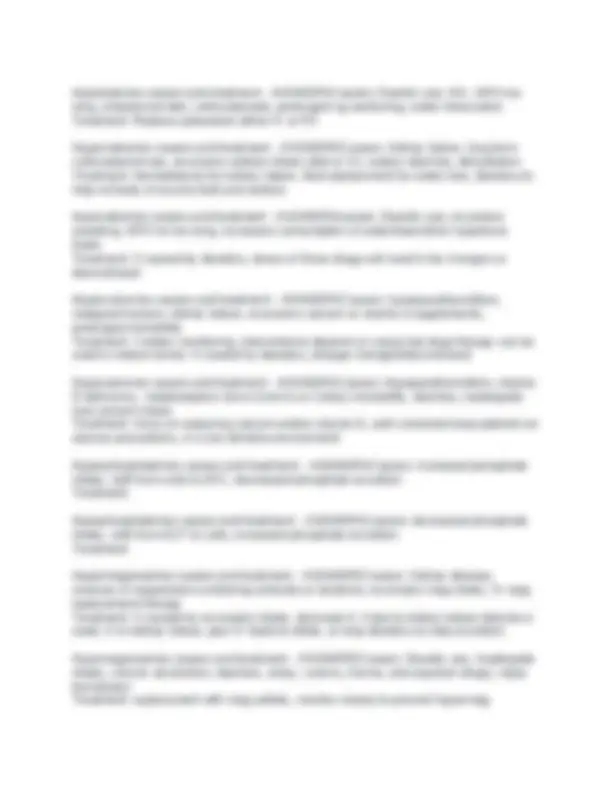
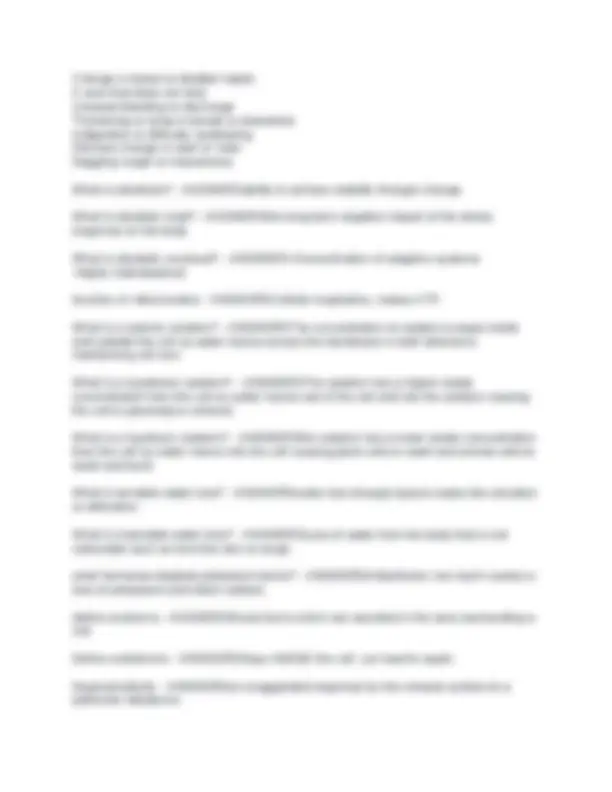
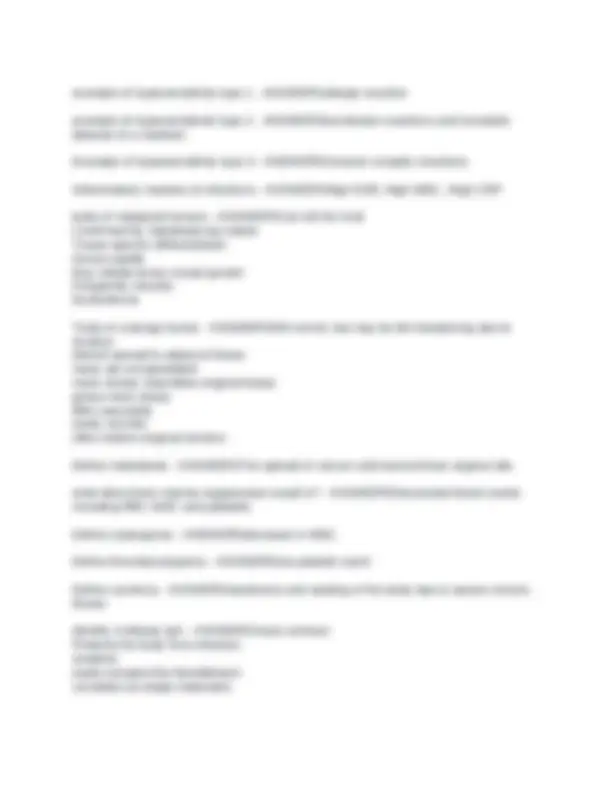
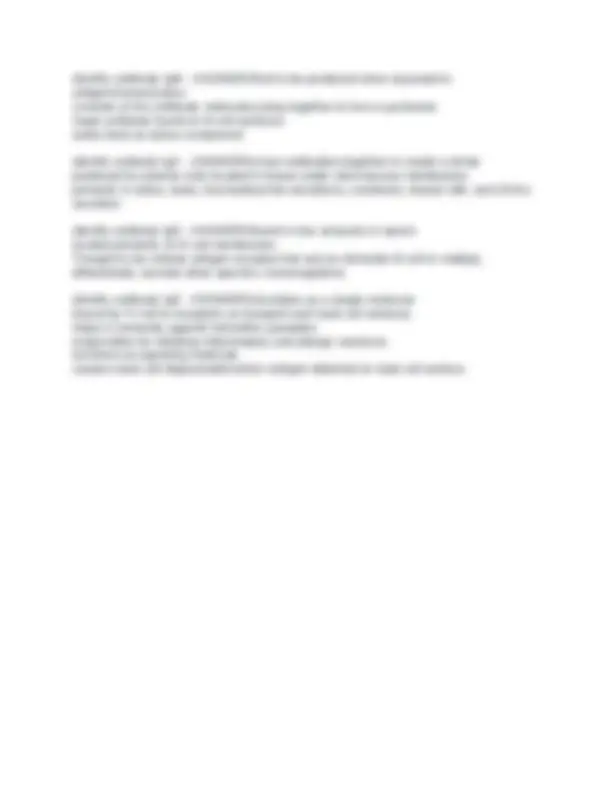


Study with the several resources on Docsity

Earn points by helping other students or get them with a premium plan


Prepare for your exams
Study with the several resources on Docsity

Earn points to download
Earn points by helping other students or get them with a premium plan
Community
Ask the community for help and clear up your study doubts
Discover the best universities in your country according to Docsity users
Free resources
Download our free guides on studying techniques, anxiety management strategies, and thesis advice from Docsity tutors
A comprehensive set of questions and answers related to pathophysiology, covering key concepts such as electrolyte imbalances, inflammation, and the immune system. It is a valuable resource for students preparing for exams or seeking to deepen their understanding of the subject.
Typology: Exams
1 / 10

This page cannot be seen from the preview
Don't miss anything!







passive immunity - ANSWERSTransfer of performed antibodies against a specific antigen from protected or immunized individual to an unprotected or non-immunized individual Examples of passive immunity - ANSWERSIgA in breast milk, maternal IgG crossing placenta, antitoxin, serotherapy (direct injection of antibodies) Potassium Value normal range( intercellular cation) - ANSWERS3.5-5.0 mEq/L Sodium value normal range (major cation of extracellular fluid) - ANSWERS135- mEq/L Calcium value normal range - ANSWERS9-11 mg/dL OR 4.5-5.5 mEq/L Phosphate value normal range - ANSWERS2.5-4.5 mg/dL Magnesium value normal range - ANSWERS1.5-2.5 mEq/L Bicarbonate value normal range (second most abundant anion in blood) - ANSWERS23-30 mEq/L Condition of low potassium < 3.5 mEq/L - ANSWERShypokalemia Condition of high potassium >5 mEq/L - ANSWERSHyperkalemia Condition of sodium < 135 mEq/L - ANSWERShyponatremia / hypernatremia Condition of high sodium>145 mEq/L - ANSWERShypernatremia condition of low phosphate < 2.5 mg/dL - ANSWERShypophophatemia
Condition of high phosphate > 4.5 mg/dL - ANSWERSHyperphosphatemia Condition of low chloride <96 mEq/L - ANSWERShypochloremia Condition of high chloride > 106 mEq/L - ANSWERSHyperchloremia Condition of low magnesium <1.5 mEq/L - ANSWERShypomagnesemia Condition of high magnesium >2.5 mEq/L - ANSWERSHypermagesemia condition of low calcium< 9mg/dL - ANSWERShypocalcemia condition of high calcium > 11mg/dL - ANSWERShypercalcemia Pathophysiology - ANSWERSthe study of abnormalities in physiologic functioning of living beings Pathology - ANSWERSthe study and diagnosis of disease through examination of organs, tissues, cells, and bodily fluids Etiology - ANSWERSThe study of the causes and origins of disease 4 topics of pathophysiology - ANSWERSetiology, pathogenesis, clinical manifestations, treatment pathogenesis - ANSWERSdevelopment or evolution of a disease clinical manifestation - ANSWERSsigns and symptoms or evidence of disease exacerbation - ANSWERSa relatively sudden increase in the severity of a disease or any of its signs and symptom remission - ANSWERSdecline in severity of symptoms sequela - ANSWERSa disorder or condition usually resulting from a previous disease or injury acute - ANSWERSsudden onset and short duration chronic - ANSWERSlong term Primary level of prevention - ANSWERSaltering susceptibility; reducing exposure for susceptible persons
Hyperkalemia S/S - ANSWERSMild cramping, hyperactive bowel sounds, diarrhea, muscle weakness starting in lower extremities and ascends, Bradycardia, Dysrhythmias, Tall T waves on ECG, Cardiac arrest Hypocalcemia S/S - ANSWERSDiarrhea, Numbness, Tingling of extremities and around mouth, Convulsions, Positive Chvostek sign, Positive Trousseau sign, painful cramps ('charlie horses') Brady, brittle bones, Hypercalcemia S/S - ANSWERSMuscle weakness, Constipation, Anorexia, N/V, Polyuria, confusion, increased HR and BP, Dysrhythmias, blood clots form easily, risk for DVT Hyponatremia S/S - ANSWERShyperactive bowel sounds, Weakness, Lethargy, Confusion, Muscle cramps, Twitching, Seizures, Coma, Death Hypernatremia S/S - ANSWERSS = Skin flushed A = Agitation L = Low-grade fever T = Thirst eye twitching Hypophosphatemia S/S - ANSWERS↓Cardiac Output and Contractility Slowed Respirations Weakness ↓DTR ↓Bone Density Irritability/Confusion/Seizures ↓Platelet aggregation ↑Bleeding Immunosupression Hyperphosphatemia S/S - ANSWERSCauses hypocalcemia: +Trousseau's and Chvosteks Hypomagnesemia S/S - ANSWERSTorsades de Pointes (tornado in the heart) Afib, Vfib, Prolonged QT, flattened T wave, N/T, painful muscle contractions, decreased GI, constipations, nausea, paralytic ileus Hypermagnesemia S/S - ANSWERSBrady, hypotension, cardiac arrest, lethargy, coma, resp failure, death Hyperkalemia causes and treatment - ANSWERSCauses: ACE inhibitors, kidney failure, multiple blood transfusions, excessive or too rapid IV potassium Treatment: Excrete excess potassium (with drugs), force potassium from ECF back into cells
Hypokalemia causes and treatment - ANSWERSCauses: Diuretic use, N/V, NPO too long, unbalanced diet, corticosteroids, prolonged ng suctioning, water intoxication Treatment: Replace potassium either IV or PO Hypernatremia causes and treatment - ANSWERSCauses: Kidney failure, long term corticosteroid use, excessive sodium intake (diet or IV), watery diarrhea, dehydration Treatment: Hemodialysis for kidney failure, fluid replacement for water loss, diuretics to help rid body of excess fluid and sodium Hyponatremia causes and treatment - ANSWERScauses: Diuretic use, excessive sweating, NPO for too long, excessive consumption of water/beer/other hypertonic fluids Treatment: if caused by diuretics, doses of those drugs will need to be changes or discontinued Hypercalcemia causes and treatment - ANSWERSCauses: hyperparathyroidism, malignant tumors, kidney failure, excessive calcium or vitamin d supplements, prolonged immobility Treatment: Cardiac monitoring, interventions depend on cause but drug therapy can be used to reduce levels. If caused by diuretics, dosage changed/discontinued Hypocalcemia causes and treatment - ANSWERSCauses: Hypoparathyroidism, vitamin D deficiency, malabsorption (from Crohn's or Celiac) immobility, diarrhea, inadequate oral calcium intake Treatment: focus on replacing calcium and/or vitamin D, until corrected keep patients on seizure precautions, in a low stimulus environment Hyperphosphatemia causes and treatment - ANSWERSCauses: increased phosphate intake, shift from cells to EFC, decreased phosphate excretion Treatment: Hypophosphatemia causes and treatment - ANSWERSCauses: decreased phosphate intake, shift from ECF to cells, increased phosphate excretion. Treatment: Hypermagnesemia causes and treatment - ANSWERSCauses: Kidney disease, overuse of magnesium-containing antacids or laxatives, excessive mag intake, IV mag replacement therapy Treatment: If caused by excessive intake, decrease it, if due to kidney failure dialysis is used, if no kidney failure, give IV fluids to dilute, or loop diuretics to help excretion. Hypomagnesemia causes and treatment - ANSWERSCauses: Diuretic use, inadequate intake, chronic alcoholism, diarrhea, celiac, crohns, chemo, anti-rejection drugs, mass transfusion Treatment: replacement with mag sulfate, monitor closely to prevent hypermag
antimicrobial resistance - ANSWERSoccurs when pathogens undergo changes that allow them to resist antimicrobials (Ex: MRSA) mediators of acute inflammation - ANSWERShistamine, serotonin, bradykinin, prostaglandins, leukotrienes Osteoporosis - ANSWERSA condition in which the body's bones become weak and break easily. muscular dystrophy - ANSWERSgroup of hereditary diseases characterized by degeneration of muscle and weakness Fibromyalgia - ANSWERSchronic condition with widespread aching and pain in the muscles and fibrous soft tissue myasthenia gravis - ANSWERSa chronic AUTOIMMUNE disease that affects the neuromuscular junction and produces serious weakness of voluntary muscles Osteoarthritis - ANSWERSa degenerative joint disease in which the cartilage covering the surface of bone becomes thinner and rougher (noninflammatory) rheumatoid arthritis - ANSWERSa chronic AUTOIMMUNE disorder in which the joints and some organs of other body systems are attacked Psoriatic arthritis - ANSWERSAn inflammatory arthritis associated with psoriasis of the skin Herpes - ANSWERSA viral infection causing small painful blisters and inflammation, most commonly at the junction of skin and mucous membrane in the mouth or nose or in the genitals (1 above waist, 2 below) Goes dormant and can come back as shingles. Gout - ANSWERShereditary metabolic disease that is a form of acute arthritis, characterized by excessive uric acid in the blood and around the joints atopic dermatitis - ANSWERSExcess inflammation; dry skin, redness, and itching from allergies and irritants. (eczema) osteocarcoma - ANSWERSa malignant tumor of the bone and is most common in the mandible. Steps of carcinogenesis - ANSWERS1. Initiation (DNA damage/mutation)
Change in bowel or bladder habits A sore that does not heal Unusual bleeding or discharge Thickening or lump in breast or elsewhere Indigestion or difficulty swallowing Obvious change in wart or mole Nagging cough or hoarseness What is allostasis? - ANSWERSability to achieve stability through change What is allostatic load? - ANSWERSthe long-term negative impact of the stress response on the body What is allostatic overload? - ANSWERS-Overactivation of adaptive systems -Highly individualized function of mitochondria - ANSWERSCellular respiration, makes ATP. What is a isotonic solution? - ANSWERSThe concentration of solutes is equal inside and outside the cell so water moves across the membrane in both directions maintaining cell size What is a hypertonic solution? - ANSWERSThe solution has a higher solute concentration than the cell so water moves out of the cell and into the solution causing the cell to plasmolyze (shrivel) What is a hypotonic solution? - ANSWERSthe solution has a lower solute concentration than the cell so water moves into the cell causing plant cells to swell and animal cells to swell and burst What is sensible water loss? - ANSWERSwater loss through typical routes like urination or defication What is insensible water loss? - ANSWERSLoss of water from the body that is not noticeable such as from the skin or lungs what hormones depleat potassium levels? - ANSWERSAlderstrone. too much causes a loss of potassium and retain sodium. define exotoxins - ANSWERSthose toxins which are secreted in the area surrounding a cell Define endotoxins - ANSWERSStays INSIDE the cell. can lead to septic Hypersensitivity - ANSWERSan exaggerated response by the immune system to a particular substance
Identify antibody IgM - ANSWERSfirst to be produced when exposed to antigen/immunization consists of five antibody molecules joing together to form a pentamer major antibody found on B-cell surfaces. works best as active component identify antibody IgA - ANSWERSis two antibodies together to create a dimer produced by plasme cells located in tissue under skin/mucous membranes primarily in saliva, tears, tracheobrachial secretions, colostrum, breast milk, and GI/GU secretion identify antibody IgD - ANSWERSfound in tiny amounts in serum located primarily on B cell membranes Thought to be cellular antigen receptor that acts to stimulate B cell to multiply, differentiate, secrete other specificc immunoglobins Identify antibody IgE - ANSWERScirculates as a single molecule bound by Fc tail to receptors on basophil and mast cell surfaces helps in immunity against helminthic parasites responsible for initiating inflammatory and allergic reactions functions as signaling molecule causes mast cell degranulationwhen antigen detected at mast cell surface.